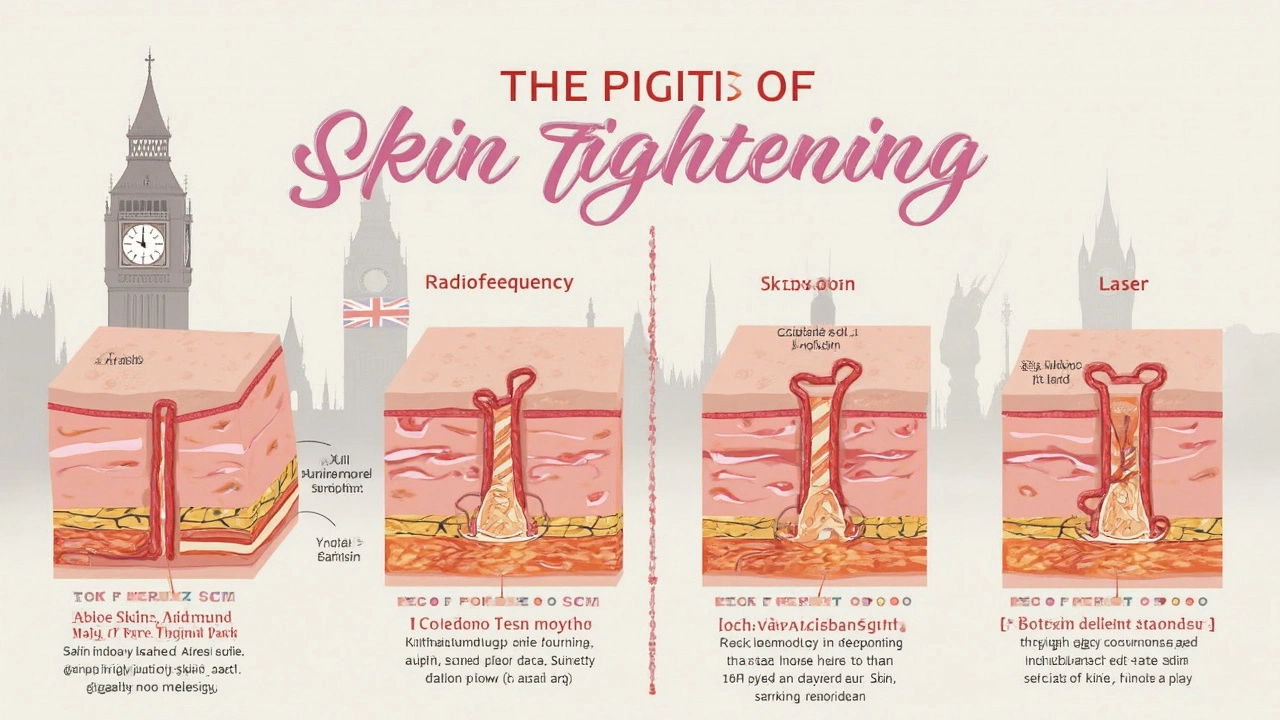What's the Top Skin Tightening Treatment?
 Apr, 16 2025
Apr, 16 2025
Alright, let's talk about skin tightening. At some point, we all peek in the mirror and notice a little extra sag here or there. No biggie, it's just life, right? But if you're eyeing something to firm things up without involving a scalpel, you're in luck. Non-surgical skin tightening treatments are all the rage right now.
So, why are folks steering clear of surgical routes? Simple: less downtime, fewer risks, and let's not forget, they're generally easier on the wallet. Technology today offers a bunch of options, and they all promise to tighten up that pesky loose skin.
Take radiofrequency, for instance. This tech uses energy waves to heat up the deep layers of your skin, which helps to boost collagen production. And who doesn't want more collagen, right? It's like giving your skin a mini workout session.
- Understanding Skin Tightening
- Why Non-Surgical is Popular
- Radiofrequency Treatments
- The Power of Ultrasound
- Laser Options Explained
- Choosing the Right Treatment
Understanding Skin Tightening
So, what's the deal with skin tightening? At its core, it’s all about making your skin firmer and more toned by kicking up collagen production. When we're young, our bodies naturally produce plenty of collagen. That’s what keeps our skin looking all perky and fresh. But as we age, that production slows down, causing that oh-so-lovely sagging.
Think of collagen as the scaffolding that keeps your skin supported. Without enough scaffolding, everything starts to droop a bit. The magic behind these non-surgical facial treatments is their ability to stimulate collagen production using energy-based tech like radiofrequency, ultrasound, and laser.
Here's how these methods work. They heat the deeper layers of the skin, which tricks your body into thinking it's been lightly damaged. As a result, your body rushes to produce new collagen to 'repair' that perceived damage, leading to tighter skin. It’s like a wake-up call for your skin cells, saying, 'Hey, get to work!'
A little-known fact is that even environmental factors like sun exposure can affect how our skin maintains its firmness. This is why combining these treatments with good skincare habits—like wearing sunscreen and hydrating—can really make a difference.
So, if the idea of boosting collagen and elasticity sounds enticing without the knife, skin tightening treatments might just be your skin’s new BFF.
Why Non-Surgical is Popular
Alright, let's get into why non-surgical options are getting all the love these days. Surgical procedures, while effective, come with a laundry list of stuff to worry about: long recovery times, invasive techniques, and let's face it—the cost can scare off anyone who's not diving into their savings.
Non-surgical skin tightening treatments are like the chill cousin of surgery. They promise similar results like firmer skin and a youthful look without putting your life on hold. You can have a treatment and basically waltz out the door—no need to hide away for weeks while you heal.
And here's what makes them really hit the spot:
- Cost-effective: These treatments are often kinder to your wallet than a full-on facelift.
- Minimal downtime: You can often return to your regular activities the same day.
- Fewer risks: Non-surgical procedures generally carry fewer risks and side effects than surgical approaches.
- Natural results: Since these treatments usually stimulate your body's natural processes, the before and after can be subtle, which avoids that "tightened" look.
For folks on the run or those just wanting a quick boost, non-surgical options are kind of like the perfect skincare hack. And if you're worried about results, many claim that with regular treatments, you can bump up that lasting youthful vibe.
Look at it this way: about 70% of people who choose non-surgical procedures rave about their decision, citing both short-term and long-term benefits. Skin tightening treatments are here to stay, and as technology gets even better, they're only going to get more popular.
Radiofrequency Treatments
If you're searching for a simple way to tighten your skin without surgery, radiofrequency treatments might just be your new best friend. These nifty sessions work by using energy waves to heat up the deep layers of your skin. The goal? Stimulate collagen production. Think of collagen as your skin's natural scaffolding—it keeps everything nice and firm.
One of the big perks of radiofrequency is that it's non-invasive, meaning there's no slicing and dicing involved. You get to stroll out right after your session, maybe with slightly rosy cheeks, but mostly just ready to show off your refreshed skin. Who doesn't love an instant perk?
Now, if you're the kind of person who likes numbers, here's a fun fact: many people start noticing tighter skin after one session, but most see the best results after about 4 to 6 treatments. It's a bit like going to the gym. You don't get a six-pack after one workout.
Here's how it usually works:
- The technician applies a gel on the area for smooth gliding of the device.
- The device emits radiofrequency waves, heating the skin layers beneath.
- You might feel a warm sensation, but it shouldn't be painful.
- The session usually lasts anywhere from 20 to 45 minutes, depending on the area.
Most people find the process pretty relaxing. It's like getting a warm facial without any prickles. However, it's always wise to chat with your skincare expert about any concerns, especially if you have sensitive skin.
Oh, and if you're itching for data, here's a quick look:
| Session Number | Average Improvement Noticed |
|---|---|
| 1-2 | Subtle tightening and texture boost |
| 3-4 | Noticeable lift and firmness |
| 5-6 | Optimal results with refreshed appearance |
Overall, if you're hunting for a non-surgical approach to boost your skin, radiofrequency could be worth exploring. It's a blend of ease and effectiveness, making it a favorite among beauty enthusiasts. Plus, it's always a bonus when you don't have to clear your calendar for post-treatment recovery!

The Power of Ultrasound
Ultrasound skin tightening treatments are buzzing in the beauty world and for good reason. Known for their precision, these treatments use sound waves to penetrate the deeper layers of your skin. Unlike radiofrequency, ultrasound goes deeper, targeting the foundational layers that are usually addressed in surgical facelifts.
This treatment is super popular because it stimulates collagen production, much like other non-surgical options, but it does so in a way that's more controlled and precise. This makes ultrasound ideal for those looking for targeted, noticeable results. Plus, it's relatively quick with minimal downtime, which is a huge plus if you're not up for an extended recovery period.
Here’s how it generally works: A handpiece delivers concentrated sound waves deep into the skin, warming the tissue and stimulating the body's natural wound-healing response. This response kickstarts the creation of new collagen, gradually lifting and tightening the skin.
To give you a clearer picture, many patients report feeling some heat and tingling during the process, which is the device in action. Some even compare it to a warm massage, making it less intimidating than you might think.
- Session Time: Around 30 to 90 minutes, depending on the area.
- Results Duration: Noticeable after about three months, with improvements lasting a year or more.
- Ideal For: Mild to moderate skin laxity, especially on the face, neck, and décolletage.
A study published last year showed over 80% of patients were satisfied with the results of their ultrasound treatments. They loved the firmer, tighter skin without looking 'done.'
Now, is it a one-size-fits-all? Maybe not. It's perfect if you're seeing the first signs of aging but remember, results can vary based on skin type and age. Having a consultation with a certified practitioner can help you figure out if this is the right match for your skin tightening goals.
Laser Options Explained
Lasers! No, not the sci-fi weaponry kind, but the ones that actually tighten skin. When it comes to skin tightening, laser treatments have their own charm. They're precise, highly effective, and might just be the ticket to rejuvenating your appearance without surgery.
So, how do lasers work their magic? Essentially, they shoot concentrated beams of light at your skin, which may sound a bit intense, but it's pretty safe. What happens next is some serious action beneath the surface. The laser heats the skin, leading to collagen contraction and stimulation of collagen production. Over time, this process can tighten and lift the skin, reducing sagging and fine lines.
There are two main types of laser treatments used for facial treatments: ablative and non-ablative lasers. Ablative lasers are more aggressive, removing the outer layer of skin to reveal fresher skin beneath, making them a better choice for significant changes. The downside? A bit more downtime is needed for recovery. On the flip side, non-ablative lasers are gentler, focusing on the deeper layers of skin without damaging the surface. These might require more sessions, but they come with less recovery hassle.
Here's a quick look at some popular laser options:
- CO2 Lasers: Known as the 'gold standard' for ablative lasers, these are powerful and effective, especially for deeper wrinkles and very loose skin.
- Fraxel Lasers: These target a fraction of skin at a time, focusing on deeper layers to encourage new collagen growth and repair.
- Pulsed-Dye Lasers: Typically used for redness or visible scars, they also promote skin firmness by encouraging collagen production.
When considering laser treatments, it's super important to consult with a dermatologist or certified specialist who can recommend the best option for your specific skin type and concerns.
Here’s a nifty table comparing some vital aspects of these treatments:
| Laser Type | Aggressiveness | Recovery Time | Best For |
|---|---|---|---|
| CO2 | High | 1-2 weeks | Deep wrinkles |
| Fraxel | Moderate | 3-5 days | Aging signs, scars |
| Pulsed-Dye | Low | 1-3 days | Redness, minor sagging |
Remember, like any beauty treatment, you’ll want to weigh the benefits against potential side effects and the cost. Lasers might sound intense, but for many, they're a game-changer in achieving firmer, glowing skin!
Choosing the Right Treatment
So, you’re ready to jump on the skin tightening bandwagon but feeling a bit lost with all the options? Don't worry, you're not alone. Picking the right treatment can feel like navigating a minefield, but it's all about matching your skin type and needs with the best tech out there.
First things first, consider your skin's quirks. Is it sensitive? Do you break out easily? If you're nodding, you might want to lean towards ultrasound therapies which are known for being gentler. On the other hand, if you're battling deep sagging, perhaps radiofrequency treatments could be your new best friend since they dive deeper into the skin layers.
Here’s a wise pointer from Dr. Emily Harper, a renowned dermatologist:
“Always have a professional consultation before jumping into treatments. Personalized plans take into account your skin’s unique characteristics and history, ensuring safer and more effective results.”
Now, those thrilling clinical-sounding laser treatments. They’re super popular because they can target problem areas with precision. If wrinkles and sunspots are on your hit list, laser might just hit the spot. Just remember, they might involve a bit more downtime for healing.
For those still hesitant, check out this quick comparison:
| Treatment Type | Best For | Healing Time |
|---|---|---|
| Radiofrequency | Deep sagging skin | Minimal |
| Ultrasound | Sensitive skin | None to minimal |
| Laser | Wrinkles & spots | Short to moderate |
In the wild world of facial treatments, there's no one-size-fits-all. Balancing effectiveness with safety and comfort is key. The right treatment will leave your skin looking refreshed, so it's worth doing a little homework. And when in doubt, reach out to a pro who can guide you toward the best option for you.
